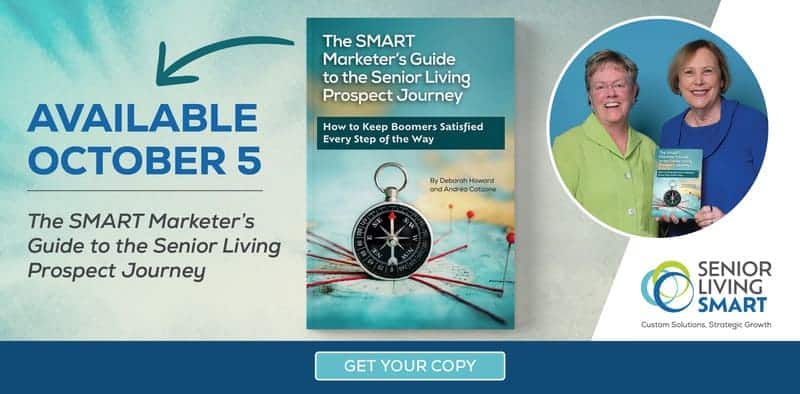Senior Living Website Design: Tips to Boost Conversions
Senior living website design involves so much more than fonts, colors, images, and layout. Sure, those things are important. But if your site only looks pretty, but doesn’t convert anonymous website traffic into leads, what’s the point?
Bottom line: Your design strategy must go hand-in-hand with your overall marketing strategy. Follow these tips to accomplish exactly that.
Design your site for multiple buyer journey “pathways.”
Remember, the buyer controls the sales process, not the other way around. In fact, buyers often interact with content anywhere from 8-10 times (if not more) before showing any interest in talking to sales.
As a result, your senior living website design needs to enable the buyer to take the next logical step in their specific journey. On the home page, provide clear paths. If they self-identify as an older adult researching senior living communities for a move within the next year, provide a logical path through the site. The same is true for an adult child looking on behalf of a parent.
By providing paths that reflect each buyer’s journey, you’ll increase conversions along the way. How so? Well, the various conversion points will happen in a way that makes sense to that particular buyer.
For example, for the adult child, you’d offer content downloads that make sense to them, such as “A Guide to Helping Loved Ones Make the Move to Senior Living.” On the flip side, for an older adult evaluating different communities, you might offer content like: “What to Expect in Your First Month Living in Our Community.”
On any given page, make it clear what people should do next.
Your senior living website serves as your virtual storefront. Brick-and-mortar retail stores are designed to lead people deeper and deeper into the store so that they stay in-store longer. (The same is true with grocery stores—that’s why the meat and deli departments are in the back of the store.)
Your senior living website design needs to do the same thing: You need to entice people to stay and explore your site. Here are some strategies for keeping people invested:
- Use sticky menus. Navigation that remains at the top even as people scroll can be an excellent way to keep people oriented as to where they are—and to stop them from backing out in frustration.
- Use well-designed and thoughtfully placed CTAs. The CTAs should lead people to valuable content that will help them on their journey. Read more about the power of CTAs in senior living marketing.
- Use video. Video tends to increase the time spent on a page. Studies suggest that including video on landing pages can increase conversions by as much as 80%. But like anything else, you need to be thoughtful in how you use video—where it’s placed, how it integrates with the page, how quickly it loads, and so forth.
Be mindful of how your senior living website design renders across all devices.
Creating a consistent experience is key to consistent conversions. If the desktop experience is fine, but the experience on a phone leaves a lot to be desired, you might lose the person to a competitor simply due to that frustrating experience.
When we say a “consistent” experience, we don’t simply mean making sure the site looks exactly the same across all devices. The experience on smartphones should be different from the experience a person has on a desktop since they are two very different devices. What you want to avoid is having someone experience a disconnect from one device to another—the branding should be consistent, as should the pathways people follow. But how you optimize your site for mobile will and should be different.
For example, you might need to adjust CTA designs so that they’re super easy to read on mobile. Your font and text size on mobile might need to be different from the desktop experience. You get the idea. (Need more tips? Read HubSpot’s article on how to optimize websites for mobile users.)
Now, if you’re thinking smartphones aren’t as popular with your key demos, think again. Sure, the Silent Generation (born 1925 to 1945) might not be married to them. But the demo right behind them—Baby Boomers—most certainly are (and so are their kids). In fact, according to this report from HigherVisibilty, “In the first quarter of 2021, 54.8% of web searches were done via mobile devices (excluding tablets).” And guess what? That number is only going to go up.
Practice good technical SEO.
When we talk about search engine optimization (SEO), we’re usually discussing it in relation to the copy on the page. But technical SEO is just as important. And that’s specifically something the web team needs to shoulder.
What is technical SEO? Backlinko has a good definition: “Technical SEO is the process of ensuring that a website meets the technical requirements of modern search engines with the goal of improved organic rankings. Important elements of Technical SEO include crawling, indexing, rendering, and website architecture.”
Run A/B testing with various elements of your senior living website design.
If you want to boost conversions, run A/B tests of various design elements to see which ones give you the biggest increase. Simple things—from font size to text color—can greatly impact conversions.
SEO guru Neil Patel lists 19 obvious A/B tests to conduct on your website. His recommendations include:
- Typography
- Colors
- Font size
- CTA design and placement
- Landing page styles (long copy vs. short copy – layout plays a critical role)
Don’t treat your senior living website as a static thing.
This is especially true after launching a new site—or relaunching an existing site. It’s easy to think the heavy lifting is over and that you can just sit back. While this might have been OK a decade ago, it’s not the case today. Monitor analytics (especially on high-priority landing pages), conduct A/B testing, and adjust things, as needed.
Experiment with interactive elements within your senior living website design.
Building off the above point, be willing to try different things, from live chat to pop-ups. The challenge is seamlessly working these elements into your senior living website design so that they feel natural rather than intrusive. (And the look-and-feel needs to reflect the brand.)
Need help rocking your senior living website design?
Let’s boost conversions on your senior living website. Either opt for our budget-friendly website audit. Or we can chat about a custom strategy. Either way, get in touch!








